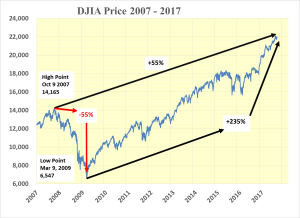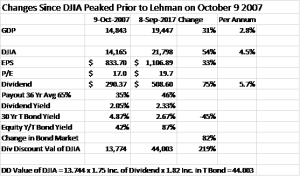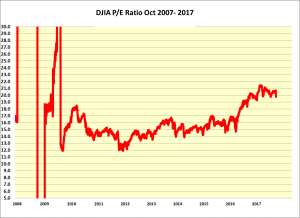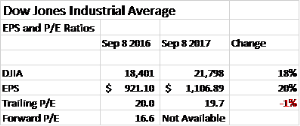Past price action no guide to future
Looking solely at the price of the DJIA over the past decade it can be seen where it has been. However, it tells nothing about its value, neither does it tell why the price has changed nor about where it is going.

There have been a number of changes in the fundamentals that are commonly thought to impact the price of the DJIA. The U.S. GDP, the DJIA earnings, the PE ratio.
There have also been changes in the two main factors that determine the value of the DJIA, the dividends and the 30 year T bond yield. The latter, of course, has a direct impact on the changes of the value and price of the bond market.

P/E Ratio Not Be All and End All, Particularly in Isolation.

Perceived wisdom holds that the DJIA is forward looking. If this is the case why are so many pundits crying that the P/E multiple is too high?

The same cry has been heard for over a year. But if this year’s actual earnings had been correctly forecast last year and used to calculate the forward P/E multiple of 16.6 then the clamor to sell might have been more muted.
In the event, DJIA earnings are up 20% while the price of the DJIA is up 18%. If there was no need to panic and sell last year why should there be a rush for the exits now?

Using the P/E ratio on its own is not helpful. It has been extremely volatile, moving towards infinity as earnings fall in recessions and towards negative infinity as losses were incurred during the Lehman fiasco. The average P/E ratio over the past 36 years has been 20.2 on historical earnings. Slightly more than the current ratio of 19.7. On its own, this suggests that the DJIA is fairly priced.
P/E Multiple Has to be Viewed in Context of 30 Year T Bond Yield
However, this is without any reference to the prevailing 30 Year T bond yield, which has fallen from 15.2% on September 29, 1981, to 2.67%. The bond market has been in a phenomenal bull market for 36 years with its price rising 5.69 times. Falling long term rates should have had, and did have, a positive impact on the P/E multiple of the DJIA until the Lehman catastrophe.













Leave A Comment